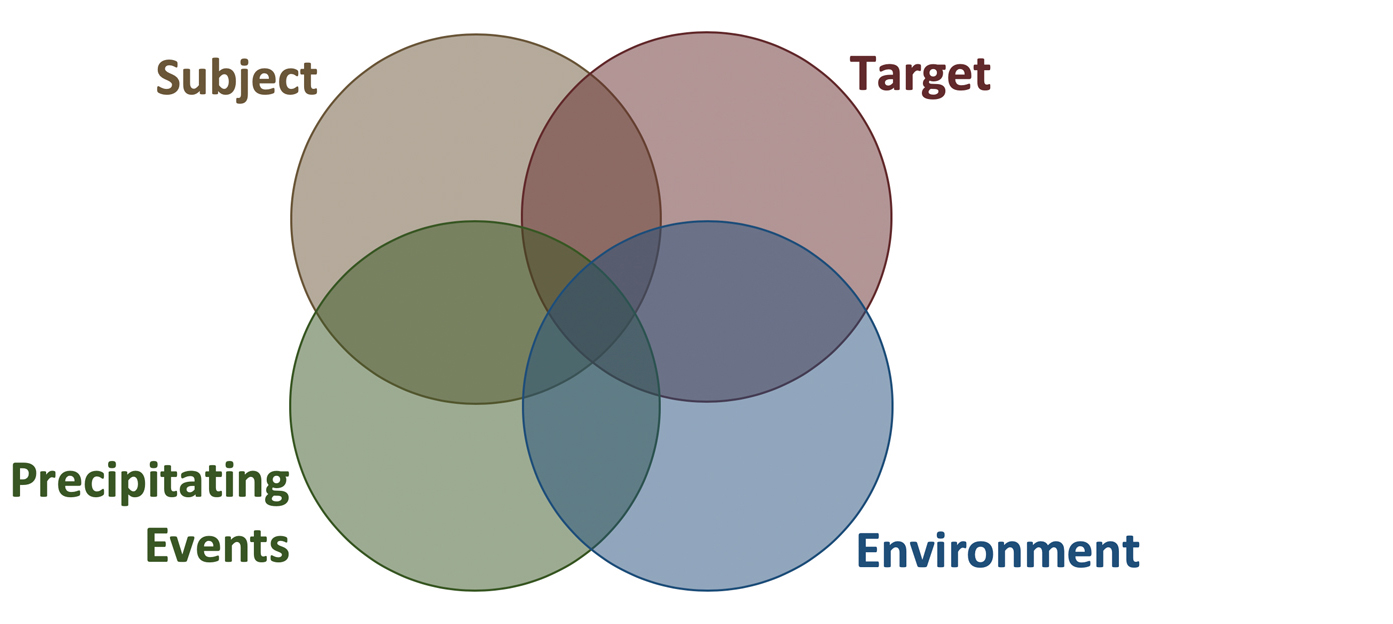TxSSC
School Behavioral Threat Assessment Toolkit
6.0 Guiding Principles of Threat Assessment1
Several key principles guide the threat assessment and management process:
- Targeted violence is the end result of an understandable, and usually, discernible, process of thinking and behavior.
Individuals who have committed targeted violence did not “just snap,” but engaged in a process of thought and behavior that escalated over days, weeks, months, and even years. Targeted violence stems from an interaction among the Subject(s), Target(s), Environment and Precipitating Incidents (STEP).
Identifying, preventing, and intervening with acts of violence requires a focus on the four components below and their interaction:Subject of concern - should provide insight into how the individual perceives and deals with conditions, often stressful, in his or her life and the intensity of effort they direct toward planning and preparation for violence.
- Target – examine access that the subject has to the target and ways to decrease a target’s vulnerabilities, and/or the role that target appears to play in subject’s intended goals.
- Environment - examines school or workplace climate and systemic issues that contribute to the risk of violence, or do not discourage it.
Precipitating events - should examine critical stressors or events such as bullying, personal losses, enforcement actions, or even threat assessment team interventions, that may increase or decrease the risk for violence.

An investigative, skeptical, inquisitive mindset is critical to successful threat assessment.
Threat assessment team members must strive to be accurate, fair, and diligent in gathering data to identify consistencies and inconsistencies to gain understanding of the context and situation.- Effective assessment is based upon facts and observations of behavior, rather than on characteristics, traits, or profiles.
Perpetrator profiles do not provide a reliable basis for making judgments of the threat posed by a particular individual. The threat assessment process examines the behavior of the subject in relation to the context, issues, challenges, and resources involved. This provides for an individualized, holistic, and contextually based understanding of the situation. - The central question in a threat assessment inquiry is whether a subject poses a threat (i.e., is building the capability to cause harm), not just whether the subject has made a threat (directly expressed intent to harm).
Research on targeted violence in schools and workplaces has found that fewer than 20 percent of violent perpetrators communicated a threat directly to their target before the violence. In the majority of incidents of targeted violence, perpetrators did not directly threaten their targets, but communicated their intent and/or plans to others before the violence. This indirect expression or third-party communication of intent to cause harm is often referred to as leakage. Individuals who are found to pose threats frequently do not make threats to their targets. The absence of a directly communicated threat should not, by itself, cause a team to conclude that a subject does not pose a threat or danger to self or others. - Corroboration is critical
It is important to keep in mind that a threat assessment case is an inquiry – meaning it’s a process designed to gather information and facts in order to develop a more comprehensive understanding about the person in question, his or her situation, setting, and potential targets. One hallmark of a good investigation is corroboration or fact-checking, and where possible to confirm information from other sources. - An integrated systems approach, coordinating between local agencies and service systems within the school and the community (e.g., mental health services, law enforcement), should guide threat assessment and management processes.
Relationships with agencies and service systems within the school (e.g., school psychologist, school social worker, school-based mental health clinicians, administrators, disciplinary officers, human resources, etc.) and community (e.g., mental health, juvenile justice, child welfare, law enforcement) are critical to identifying, assessing, and managing individuals who are on a path to carrying out an act of targeted violence.
References
1Virginia Department of Criminal Justice Services. (2016.) Threat Assessment in Virginia Public Schools: Model Policies, Procedures, and Guidelines. Second Edition.
Retrieved from: www.dcjs.virginia.gov/sites/dcjs.virginia.gov/files/publications/law-enforcement/threat-assessment-model-policies-procedures-and-guidelinespdf.pdf